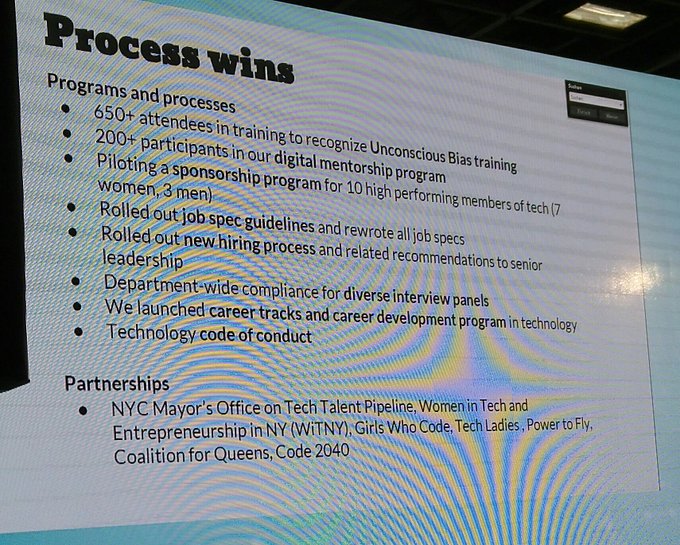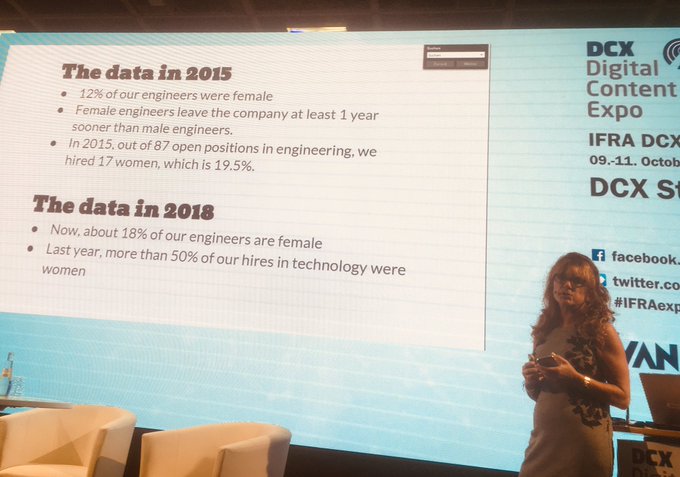CNBC reported last year that in a global survey of nearly 4500 CIOs and technology leaders, that only 9 percent of IT leaders were female. And that is despite the fact that one third of those organisations surveyed actually had diversity initiatives in place.
A powerhouse session and panel (see takeaways here) took place at IFRA World Publishing Expo and DCX Digital Content Expo yesterday that addressed some of the challenges and possibilities for publishers on this critical issue.
And it was actually Cindy Taibi of The New York Times who kicked off that session. Taibi took over the CIO position at NYT about five months ago and has been with the iconic news brand for more than 30 years in various technology positions.
Town hall turns heads at NYT
Taibi said NYT’s women in tech journey actually got off the ground because of that CTO vacancy situation three years ago. It just so happens the company was holding one of its regular “town hall” meetings with some of its audience when that same question about how many women were interviewed for the CTO job was put to the audience.
“That didn’t sit well with them and that is really what kick-started the Diversity Technology Workforce Task Force,” she said. “It’s a grass roots movement that started with the passion and dedication from the women in our department.”
With 1400 journalists around the world, reporting in some 150 countries every year and a newsroom where some 55 languages are spoken, “the global breadth of our journalistic mission is clear so building a diverse and inclusive workforce is incredibly important to our global mission,” Taibi said.
“It enhances our rapport and trust with our audience because our journalism is reported through a lens that better reflects that diverse audience. A diverse workforce ensures that we build better products that our readers and advertisers can engage with wherever and whenever they want. So while it is essential to our entire workforce, it is also essential to our technology.”
The Task Force was made up of volunteers, something Taibi said is critical, “because they bring passion and will go beyond the call of duty to drive it.”
Making the case
So how can such a movement get the buy-in from top leadership? Taibi and the rest of the panellists emphasised the following: You have to make the case for both the moral and business imperatives.
“Diversity leads to more innovation, more profitability, and products, but what a lot of people don’t know is that it leads to lower turnover and makes you more successful in recruiting to ultimately be more competitive, particularly in tech,” said Taibi. “Data is critical to get top management on board, to show that this is not just a moral obligation but a business obligation as well. You have to make that case to leadership, but I think that is not difficult in the sense that we all know that there is a lot of hard data and research out there to back that up.”
After gathering relevant quantitative and qualitative data and getting feedback from the entire organisation to ensure that everybody would benefit, the task force formulated the following mission, focusing on the three pillars of recruitment, culture and advancement…

But like any major initiative or project, one of the keys was to set clear quarterly goals and objectives that were measurable and made public to the company, said Taibi.
For recruiting and hiring, here are just a few of the actions and policies the task force set in place:
- Hiring managers must have diverse candidate slates and interview panels in place. Job descriptions had to rewritten to be more inclusive.
- To move away from on-demand hiring, i.e. only when someone leaves, and create a more diverse pipeline for proactively seeking talent. “I think this is one of the most critical aspects because it takes time to build up that pipeline to have an active list of candidates. Once that is in place, it will help to counteract delays in hiring. It also helps to maintain a relationship with a candidate and improve their experience from candidate to employee,” she said.
On the cultural side, Taibi said she was most of proud of the generous parental leave policy established for both mothers and fathers. “That was really approved because of the data we could show that illustrated how this would improve retention and hiring.” They also implemented remote working practices and home office policies.
For advancement and to overcome work experience gaps, she said the NYT improved the onboarding process to take place over a year vs. just the first few weeks or months. They have created career ladders to show how employees can advance and made that public across the org. And, like many other news organisations around diversity, created meaningful mentorship programmes.
So what have been some of the results?
Gender parity in technology: real progress made at the NYT. Cindy Taibi, Sr Vice President and CIO NYT #DCXexpo
Taibi said the company published the company-wide diversity statistics “which I think underscores the commitment to this from our leadership. You have to know that change is slow but it is progress.”
Case in point: She closed her presentation by asking the audience, “how many women were included in the new product engineering leadership group just one month ago?”
None. Taibi said she doesn’t blame male leadership for this shortcoming. In fact, she said she applauds the support she has had from her male colleagues. It just underscores the inherent challenges organisations face.





